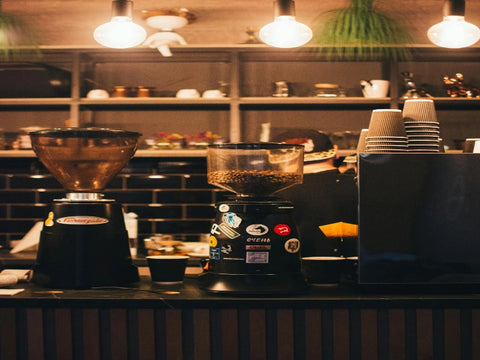Coffee machines have become a staple in many households, providing the convenience of enjoying a freshly brewed cup of coffee in the comfort of one's home. But have you ever wondered how these machines work their magic in producing your favorite cup of joe? In this article, we will delve into the mechanics of coffee machines and explore the different types, maintenance, and troubleshooting tips.
A coffee machine is a appliance designed to brew coffee by passing hot water through ground coffee beans. It typically consists of a water reservoir, heating element, pump, boiler, portafilter, and steam wand.
The process of making coffee with a coffee machine involves several steps. First, the water is heated in the reservoir and then pumped through the heating element, which brings it to the ideal temperature for brewing. The heated water is then pushed through the coffee grounds in the portafilter, extracting the flavor and aroma. The extracted coffee then flows into the coffee pot or cup. The steam wand, powered by the boiler, creates steam for frothing milk.
There are various types of coffee machines, each with its own unique mechanism. These include:
- drip coffee makers, which work by dripping hot water over the coffee grounds
- french press, which uses a plunger to press the grounds and separate them from the brewed coffee
- espresso machines, which use pressure to force hot water through the coffee grounds, creating a concentrated and flavorful shot of espresso
- pod or capsule coffee machines, which use pre-packaged coffee pods or capsules that are inserted into the machine for brewing
- moka pots, which use steam pressure to extract coffee in a similar way to espresso machines
To keep your coffee machine in optimal condition, regular maintenance is essential. This includes cleaning the machine after each use, descaling to remove mineral buildup, and replacing worn or malfunctioning parts.
Common issues with coffee machines include:
- the machine not turning on
- leaking water
- a clogged filter
- uneven extraction
- no steam pressure
These issues can often be resolved by cleaning the machine, checking for any clogs or damage, and following proper maintenance procedures.
In conclusion, coffee machines work by heating water and passing it through coffee grounds to create a delicious cup of coffee. Regular maintenance is crucial in ensuring the longevity and functionality of your machine. So the next time you enjoy your favorite cup of coffee from your machine, remember the mechanics behind its magic.
Key Takeaways:
What Is A Coffee Machine?
A coffee machine is a device that uses pressurized water to brew coffee from ground coffee beans, extracting all the flavors and aromas. It usually includes a water tank, a heating element, a pump, and a filter. These machines come in different types, such as:
- Espresso machines
- Drip coffee makers
- Single-serve pod machines
How Does A Coffee Machine Work?
Have you ever wondered what goes on inside a coffee machine to produce that perfect cup of coffee? Let’s take a closer look at the mechanics of a coffee machine and break down its various components and functions. From the water reservoir to the steam wand, we’ll uncover the inner workings of this beloved appliance and gain a better understanding of how it creates our favorite caffeinated beverages. So, let’s dive in and explore the fascinating world of coffee machine mechanics.1. Water Reservoir
- Check the water reservoir for cleanliness and fill it with fresh, filtered water.
- Make sure that the reservoir is securely placed in the coffee machine to prevent leaks and malfunctions.
2. Heating Element
The heating element in a coffee machine is a crucial component in the brewing process.
- Heat Generation: The heating element is responsible for warming the water to the optimal temperature for brewing.
- Thermostat Control: It is equipped with a thermostat to ensure that the water remains at the desired temperature consistently.
- Boil-Dry Protection: Some heating elements have a safety feature that automatically switches off when the water level is too low, preventing damage.
When choosing a coffee machine, it is important to prioritize models with efficient heating elements for a consistently flavorful brew.
3. Pump
- Ensure the coffee machine is turned off and unplugged.
- Remove the water reservoir to access the pump.
- Inspect the pump thoroughly for any blockages or debris.
- Clean the pump using a soft brush or cloth if necessary.
- Reassemble the water reservoir and plug in the machine.
Fact: The pump in an espresso machine plays a crucial role in generating the necessary pressure for extracting rich flavors from the coffee grounds.
4. Boiler
The boiler in a coffee machine is an essential component in the coffee-making process. Here are the steps involved:
- The boiler heats the water to the ideal temperature for brewing.
- It maintains a consistent temperature to ensure the high quality and delicious flavor of the coffee.
- For espresso machines, the boiler may have separate compartments for brewing and steaming milk.
5. Portafilter
- Secure the portafilter into the group head of the espresso machine.
- Grind coffee beans to the appropriate fineness, recommended for espresso.
- Fill the portafilter basket with the ground coffee and level it off.
- Tamp the coffee evenly and firmly in the portafilter to ensure proper extraction.
- Engage the espresso machine to pass hot water through the portafilter to brew the coffee.
6. Steam Wand
The steam wand, also known as the frother or steamer, is a crucial component of an espresso machine, used to steam and froth milk for drinks like lattes and cappuccinos. Here's how to use it:
- Purge the wand to clear any residual water.
- Position the Steam Wand in the milk, just below the surface.
- Turn on the steam and froth the milk until it reaches the desired temperature and texture.
Pro-tip: Always remember to wipe and purge the Steam Wand after each use to prevent milk from clogging it.
What Are The Different Types Of Coffee Machines?
Coffee machines have become an essential appliance in many households and workplaces, providing a quick and convenient way to satisfy our caffeine cravings. But have you ever wondered about the different types of coffee machines and how they work? In this section, we will delve into the mechanics of various coffee machines, from the classic drip coffee maker to the trendy pod or capsule coffee machine. By understanding the differences between these types, you can choose the best option for your coffee preferences and needs. So, let's explore the world of coffee machines and discover how they brew the perfect cup.
Read: Brew Battle Coffee Machine vs Espresso Machine Which Suits You Best
1. Drip Coffee Maker
- Measure coffee grounds: Add the desired amount of ground coffee to the filter.
- Fill water reservoir: Pour the appropriate amount of water into the Drip Coffee Maker's water chamber.
- Start the Drip Coffee Maker: Turn on the machine to begin the brewing process.
- Brewing: The machine heats the water and drips it over the coffee grounds, extracting the flavor.
- Enjoy: Once the brewing is completed, pour and savor your freshly brewed drip coffee.
2. French Press

- Coarsely grind coffee beans.
- Place the French press on a flat, heat-proof surface.
- Add the ground coffee to the French press.
- Pour hot water into the French press.
- Stir the mixture.
- Place the French press plunger on top without pushing it down.
- After four minutes, slowly push down the plunger to filter the coffee.
- Pour and enjoy your freshly brewed coffee.
3. Espresso Machine
- Grind fresh coffee beans to a fine consistency.
- Fill the portafilter with the ground coffee and tamp it down firmly.
- Lock the portafilter into the espresso machine.
- Start the extraction process, allowing hot water to pass through the coffee at high pressure.
- Monitor the extraction time to ensure the desired flavor and strength are achieved.
Pro-tip: Use a scale to measure the coffee grounds for consistency, leading to a perfect shot of espresso every time.
Read: Espresso Machines: Semi-Automatic VS Automatic VS Superautomatic
4. Pod or Capsule Coffee Machine

- Pod or capsule coffee machines provide a convenient single-serve brewing experience.
- They utilize pre-packaged coffee pods or capsules for easy cleanup and consistent taste.
- These machines are ideal for individuals looking for quick, hassle-free brewing with minimal cleanup.
The idea of the coffee pod can be traced back to 1976 when an Italian inventor patented it, laying the foundation for modern single-serve coffee machines.
Read: Coffee and Motherhood Quick Brew Tips for Busy Moms
5. Moka Pot
- Fill the lower chamber with water up to the fill line.
- Insert the funnel and fill it with finely ground coffee without compressing.
- Screw the top and bottom chambers tightly together.
- Place it on the stove over medium heat.
- Once the top chamber is full of coffee, remove it from the heat.
For a truly authentic Italian coffee experience, consider using a moka pot with finely ground Lavazza coffee for a rich and aromatic flavor.
How To Maintain A Coffee Machine?
Now that we have a basic understanding of how coffee machines work, it is important to also know how to properly maintain them. Regular maintenance can ensure that your machine produces the best quality coffee and has a longer lifespan. In this section, we will discuss the essential steps for maintaining a coffee machine, including regular cleaning, descaling, and replacing parts. By following these steps, you can keep your coffee machine in top working condition and enjoy delicious cups of coffee for years to come.1. Regular Cleaning
- For regular cleaning, make sure to remove and wash removable parts such as the portafilter, drip tray, and water reservoir regularly.
- To clean the external surfaces of the machine, use a mixture of water and detergent.
- For a thorough clean, it is recommended to regularly run a cleaning cycle with a specialized cleaning solution to remove coffee residues and mineral deposits from internal parts.
2. Descaling
Descaling your coffee machine is crucial to maintain its performance and longevity. Here's how to do it:
- Prepare the descaling solution as per the manufacturer's instructions.
- Empty the water reservoir and fill it with the descaling solution.
- Run a descaling cycle without a coffee pod to allow the solution to flow through the machine.
- Repeat the descaling cycle with clean water to rinse the machine thoroughly.
Pro-tip: Descaling every 3 months can prevent limescale buildup and ensure your coffee always tastes fresh.
3. Replacing Parts
- Identify the specific part needing replacement by diagnosing the issue.
- Refer to the coffee machine's manual for guidance on the replacement process.
- Purchase the correct replacement part for the machine from a certified dealer or manufacturer.
- Follow the manufacturer's instructions to ensure safe and proper installation of the new part.
- Test the machine after replacement to verify that it functions correctly.
What Are The Common Issues With Coffee Machines And How To Fix Them?

Coffee machines have become a staple in many households and cafes, providing us with our daily dose of caffeine. However, like any other appliance, they are prone to common issues that can hinder their functionality. In this section, we will discuss the most common problems that coffee machines face and how to troubleshoot and fix them. From the machine not turning on to issues with steam pressure, we’ll delve into the mechanics of these machines and provide solutions to keep your coffee brewing smoothly.
1. Machine Not Turning On
When your coffee machine refuses to turn on, consider the following steps:
- Check the power source and ensure the machine is plugged in.
- Inspect the power cord for any damages or loose connections.
- Look for any tripped circuit breakers or blown fuses.
- Examine the on/off switch for any malfunctions.
- Consult the user manual for troubleshooting advice.
If these steps do not resolve the issue, consider seeking professional help or contacting customer support for further assistance.
2. Leaking Water
- Check the water reservoir for cracks or damage.
- Inspect the water inlet and outlet seals for wear and tear.
- Ensure the water tank is correctly positioned and sealed.
- Examine the water tubing for any punctures or blockages.
- Verify if the machine is overfilled with water, causing leakage.
Coffee machines may experience water leakage due to worn-out seals or overfilling, making regular maintenance crucial.
3. Clogged Filter
- Turn off the coffee machine and unplug it from the power source.
- Remove the clogged filter and rinse it under running water to dislodge any coffee grounds or debris.
- Use a brush to gently scrub the filter to remove any stubborn particles.
- Soak the filter in a mixture of water and vinegar to dissolve any mineral deposits.
- Rinse the filter thoroughly and let it dry completely before reassembling it into the coffee machine.
4. Uneven Extraction
Uneven extraction in a coffee machine can result in inconsistent flavor. To address this issue:
- Make sure to evenly distribute the coffee grounds in the portafilter.
- Check the consistency and level of the tamp pressure.
- Adjust the grind size to achieve a uniform extraction.
- Consider utilizing pre-infusion to evenly saturate the coffee grounds.
- Regularly clean and maintain the machine to prevent clogging or buildup.
For an enhanced coffee experience, try experimenting with different brewing techniques and explore specialty coffee brands for unique flavors and aromas.
5. No Steam Pressure
- Check the water reservoir to ensure it is filled to the appropriate level.
- Inspect the steam wand for any blockages or clogs that may be impeding the steam pressure.
- Verify if the heating element is functioning correctly and reaching the required temperature for steam production.
- Examine the pump and boiler for any malfunctions that could be affecting steam pressure.
- If using a milk frother, ensure it is properly attached and functioning to facilitate steam pressure.
Frequently Asked Questions
What is the Bean Belt and why is it important for coffee plants?
The Bean Belt is a region between the Tropic of Cancer and the Tropic of Capricorn where coffee plants, known as evergreen tropical shrubs and small trees, thrive the most. It is important for coffee plants because it provides the ideal climate and conditions for their growth.
How do coffee beans grow and what are the two most commonly grown species?
Coffee beans are actually the seeds of the fruit of the coffee plant, known as coffee cherries. The two most commonly grown species of coffee plants are Coffee arabica (Arabica coffee) and Coffea canephora (Robusta coffee).
How does a trusty drip coffee maker work and why is it a popular choice?
A trusty drip coffee maker works by heating water in a reservoir, which is then pumped up through a tube and sprayed over coffee grounds in a filter basket. The hot water extracts the flavor and oils from the grounds and drips down into a carafe or mug. It is a popular choice for its reliability and ease of use.
What causes the gurgling noise during the brewing process and what does it indicate?
The gurgling noise heard during the brewing process is caused by the water being forced through the coffee grounds and into the carafe. It indicates that the water is properly extracting the flavor and oils from the grounds.
How is the heating element in a coffee maker responsible for its fast brewing time?
The heating element in a coffee maker quickly heats up the water, allowing for a faster brewing time. The temperature and length of time the water is in contact with the coffee grounds can affect the strength and flavor of the coffee.
What role does electrical engineering play in the inner workings of a coffee maker?
Electrical engineering is crucial in the functioning of a coffee maker. It is responsible for components such as the resistive heating element, thermal fuse, and internal check valve that allow the machine to heat up water and extract flavor from coffee grounds.



